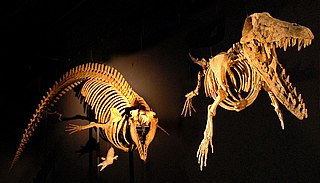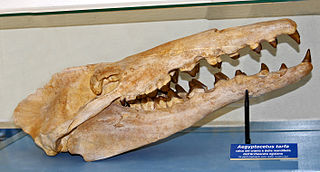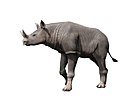
Perissodactyla is an order of ungulates. The order includes about 17 living species divided into three families: Equidae, Rhinocerotidae (rhinoceroses), and Tapiridae (tapirs). They typically have reduced the weight-bearing toes to three or one of the five original toes, though tapirs retain four toes on their front feet. The nonweight-bearing toes are either present, absent, vestigial, or positioned posteriorly. By contrast, artiodactyls bear most of their weight equally on four or two of the five toes: their third and fourth toes. Another difference between the two is that perissodactyls digest plant cellulose in their intestines, rather than in one or more stomach chambers as artiodactyls, with the exception of Suina, do.

Rodhocetus is an extinct genus of protocetid early whale known from the Lutetian of Pakistan. The best-known protocetid, Rodhocetus is known from two partial skeletons that taken together give a complete image of an Eocene whale that had short limbs with long hands and feet that were probably webbed and a sacrum that was immobile with four partially fused sacral vertebrae. It is one of several extinct whale genera that possess land mammal characteristics, thus demonstrating the evolutionary transition from land to sea.

Archaeoceti, or Zeuglodontes in older literature, is a paraphyletic group of primitive cetaceans that lived from the Early Eocene to the late Oligocene. Representing the earliest cetacean radiation, they include the initial amphibious stages in cetacean evolution, thus are the ancestors of both modern cetacean suborders, Mysticeti and Odontoceti. This initial diversification occurred in the shallow waters that separated India and Asia 53 to 45 mya, resulting in some 30 species adapted to a fully oceanic life. Echolocation and filter-feeding evolved during a second radiation 36 to 35 mya.

Anthracobune is an extinct genus of stem perissodactyl from the middle Eocene of the Upper Kuldana Formation of Kohat, Punjab, Pakistan.
Ishatherium is an extinct genus of ungulate from the early Eocene of the Subathu formation in northwestern India.
Lammidhania is an extinct genus of anthracobunids, which lived from the early to middle Eocene period. Its fossil remains were discovered in 1940 in the Chorlakki locality of the Punjab province of Pakistan.
Himalayacetus is an extinct genus of carnivorous aquatic mammal of the family Ambulocetidae. The holotype was found in Himachal Pradesh, India, in what was the remnants of the ancient Tethys Ocean during the Early Eocene. This makes Himalayacetus the oldest archaeocete known, extending the fossil record of whales some 3.5 million years.
Takracetus was a primitive cetacean that lived approximately 45 million years ago. The type specimen is a partial skull though the literature mentions a second more complete specimen.
Indobune is an extinct genus of ungulate endemic to Asia during the Eocene from 55.8—48.6 Ma, living for approximately 7.2 million years.
Ancalecetus is an extinct genus of early whale known from the Late Eocene Birket Qarun Formation in Wadi Al-Hitan, Egypt. The species is named after anthropologist and primate researcher Elwyn L. Simons who discovered the type specimen in 1985.

Chrysocetus is a genus of extinct early whale known from Late Eocene-aged fossils of the eastern United States and western Africa. It is the second smallest basilosaurid after Saghacetus.
Balochititanops is an extinct genus of brontotheriid perissodactyl from late Early Eocene deposits of Pakistan. Balochititanops is known from the holotype GSP-UM 6532, right maxilla with teeth, from Kingri area, Balochistan. Many referred materials are known and include cranial and postcranial remains. All specimens were collected from numerous localities in Balochistan and northwestern Frontier Province, from the uppermost part of the Ghazij Formation. It was first named by Pieter Missiaen, Gregg F. Gunnell and Philip D. Gingerich in 2011 and the type species is Balochititanops haqi. It represents one of the oldest Asian brontotheres.

Aegyptocetus is an extinct genus of protocetid archaeocete whale known from Egypt.
Babiacetus is an extinct genus of early cetacean that lived during the late Lutetian middle Eocene of India . It was named after its type locality, the Harudi Formation in the Babia Hills, Kutch District, Gujarat, India.

Stromerius is an extinct genus of basilosaurid early whale known from the Late Eocene of Fayum, Egypt.
Eocetus is an extinct protocetid early whale known from the early-late Eocene Giushi Formation in Gebel Mokattam, outside Cairo, Egypt. Fossil remains have also been discovered in the Aridal Formation of the Sahara Desert in southwestern Morocco.
Sivaladapis is a genus of adapiform primate that lived in Asia during the middle Miocene.
Azygonyx was a small tillodont mammal, likely the size of a cat to raccoon, that lived in North America during the Paleocene and Eocene in the early part of the Cenozoic Era. The only fossils that have been recovered are from the Willwood and Fort Union Formations in the Bighorn Basin of Wyoming, United States, and date to the Clarkforkian to Wasatchian, about 56 to 50 million years ago. Fifty-six collections that have been recovered thus far include the remains of Azygonyx. Azygonyx survived the Paleocene Eocene Thermal Maximum along with other mammals like Phenacodus and Ectocion, both of which were ground-dwelling mammals. Azygonyx probably was a generalist terrestrial mammal that may have roamed around the ground, but was also capable of climbing trees.
The Kuldana Formation is a fossil-bearing geological formation of Lutetian age which crops out in northern Pakistan. The abundant fossil remains were deposited by rivers and estuaries crossing an arid to semi-arid environment, between several marine transgressions. Its fossil fauna is best known for the early cetaceans Indohyus, Pakicetus and Ambulocetus, that helped to shed a new light on the evolution of whales, but it also features a large number of early ungulates, rodents and primates.

Drazinderetes is a large bodied genus of soft shell turtle from the Middle Eocene Drazinda Formation of Pakistan. Its presence in the shallow marine deposits of the Drazinda Formation suggests that Drazinderetes may have been a partially or fully marine animal. Indetermined trionychine remains from the same formation may suggest that Drazinderetes could have been among the largest known turtles, with one entoplastron indicating a potential length of 1.5 to 2.1 meters. Drazinderetes currently consists of only a single species: Drazinderetes tethyensis.


















